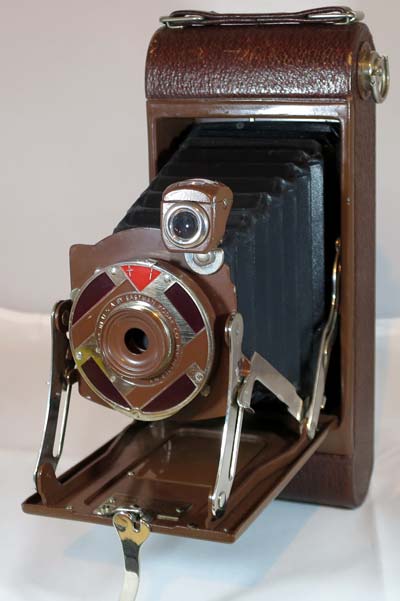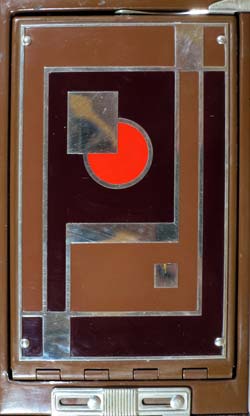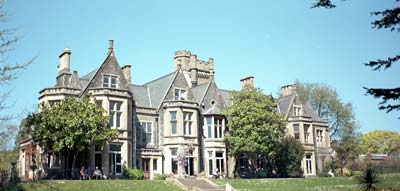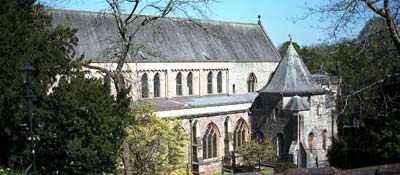No 1A Gift Kodak
Specification

| Manufacturer | : | Eastman Kodak Co. (American) |
|---|---|---|
| Produced | : | UK 1930 - 1931 |
| Classification | : | Medium Format |
| Body Type | : | Folding Bed |
| Bellows Deployment | : | Self Erecting |
| Construction | : | Metal |
| Film Type | : | 116 |
| Film Width | : | 70mm |
| No. of Images | : | 8 |
| ImageSize | : | 2½ x 4¼ in |
| Lens Type | : | Meniscus - achromatic |
| Focal Length | : | 120mm |
| Focus Type | : | Fixed |
| Focal Range | : | 10ft - inf. |
| Aperture Type | : | Multistop |
| Aperture | : | f/16, f/22, f/32, f/45 |
| Shutter Type | : | Kodo |
| Shutter Speeds | : | T, I*(1/50 sec) |
| Size Closed (w x h x d) | : | 95 x 210 x 40 mm |
| Size Open (w x h x d) | : | 95 x 210 x 160 mm |
| Weight | : | 835g |
| * Measured on this camera | ||
Art Deco Credentials
![]()
![]()
![]()
![]()
![]()
Iconic: Famous, well-known and celebrated
- Produced during the main Art Deco period.
- Designed by Walter Dorwin Teague
- Interlocking geometric shapes in black, brown, silver, and red on lens plate.
- Interlocking geometric shapes in black, brown, silver, and red on base plate.
- Brown leatherette to match body.
- Chrome struts and film door lock.
- Chrome winder and table stand.
Description

This iconic camera is a version of the No. 1A Pocket Kodak Junior. It is a self-erecting, folding camera. For the 1930 Christmas season, Walter Dorwin Teague redesigned the No. 1A Pocket Kodak Junior faceplate and box, which were usually solid black. Teague created a pattern of interlocking geometric shapes in black, brown, silver and red in Art Deco form. He got his cues from the work of modernist painters such as Mondrian. The camera reflects a convergence of art and industry. The old snobbish distinction between artist and artisan was challenged. In 1930 Kodak believed the camera to be "One of the finest looking Kodaks ever offered". It is said that the camera was intended for women. Kodak described the cameras as distinguished, dainty, and feminine and promoted them at renowned women's colleges across the country.
It takes 116 film, and has a meniscus achromatic lens. It has a Kodo shutter with instantaneous and time selector. It has 4 stops on a circular plate that rotates in front of the lens. It has a tripod mount for landscape pictures. The brown leather-covered camera had matching brown bellows, brown enamel trim and an Art Deco patterned lens panel. The pattern is repeated on the base plate and the cedar box it came in. A similar pattern is on the outer cardboard box. A total of 10,000 units were made.
All cameras had brown bellows which were soft and fragile. About 50% of the cameras offered for sale today have black bellows. These replacement bellows are generally more substantial and more serviceable. The camera in my collection has black bellows. The cedar box and cardboard outer box are missing.
How to Use
This camera is basically a Kodak 1A Pocket Junior. Find the manual for a Kodak 1A Pocket Junior here
This camera takes uses 116 film which is not available anymore except as expired films. This means that the camera needs modification to take 120 film. Modification is fairly straight forward and will easily give 5 'panoramic' exposures producing 2¼ x 4¼ inch negatives. Check out my page on 'Conversion of a 116 camera to take 120 film'. However, with this particlar camera it is not possible to use a 120 take up spool and you must use the original 116 spool and unload the camera in a darkroom directly into the developing tank. This is because the film tensioners expand as you wind on and at about frame 3 they foul the 120 spool and jam.
Once the conversion has been done, you can take it out for a spin. This camera has four aperture settings numbered 1 to 4. These are f/16(1), f/22(2), f/32(3) and f/45(4) which are changed using a rotating wheel found below the face plate. With a shutter speed of only 1/50 sec, make sure you brace the camera against your body or something solid and press the shutter smoothly to avoid camera shake. There is a tripod socket.
If you don't want to bother with an exposure meter, follow the guide below. It is based on the 'Sunny 16' rule. Film is so forgiving and will produce acceptable results even when over-exposed by 2 or 3 stops or under-exposed by 1 stop.
The tables below assume the shutter speed is about 1/50s. If you are not sure about the light level, err on the side of overexposure - i.e. assume the lower light level.
The tables also assume that the sun is at least 30 degrees above the horizon - that's 10am - 5pm on a summers day (May - August) in the UK.
I recommend ISO 400 film in this camera.
Using ISO 100/125 Film
| Weather Conditions | Shadow Detail | Aperture | Exposure |
|---|---|---|---|
 Sunny SunnySnow/Sand | Dark with sharp edges | f/32(3) | Good |
 Sunny Sunny | Distinct | f/22(2) | Good |
 Slight Overcast Slight Overcast | Soft around edges | f/16(1) | Good |
 Overcast Overcast | Barely visible | f/16(1) | -1 Stop Underexposed Acceptable |
 Heavy Overcast Heavy Overcast | None | f/16(1) | -2 Stops Underexposed Not Acceptable |
 Open Shade Open Shade/Sunset | None | f/16(1) | -3 Stops Underexposed Not Acceptable |
Using ISO 400 Film
| Weather Conditions | Shadow Detail | Aperture | Exposure |
|---|---|---|---|
 Sunny SunnySnow/Sand | Dark with sharp edges | f/45(4) | +1 Stops Overexposed Acceptable |
 Sunny Sunny | Distinct | f/45(4) | Good |
 Slight Overcast Slight Overcast | Soft around edges | f/32(3) | Good |
 Overcast Overcast | Barely visible | f/22(2) | Good |
 Heavy Overcast Heavy Overcast | None | f/16(1) | Good |
 Open Shade Open Shade/Sunset | None | f/16(1) | -1 Stop Underexposed Acceptable |
Panoramic Photographs taken with this Camera
Film - Kodak Portra 160 120


